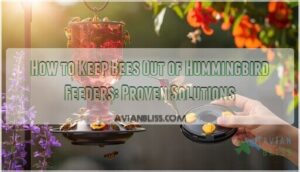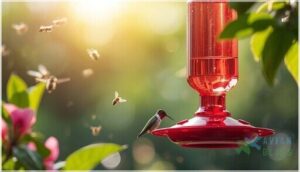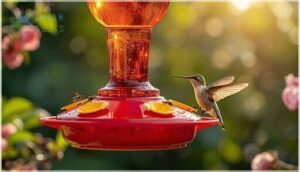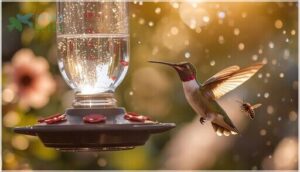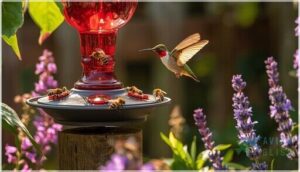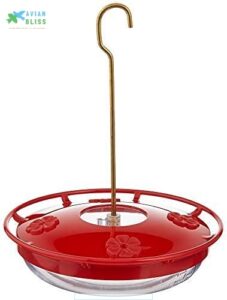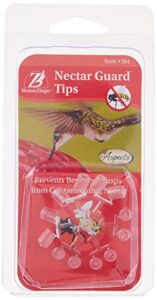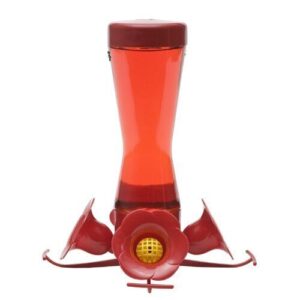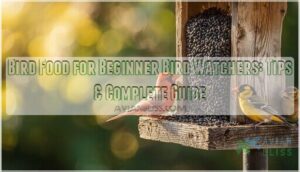This site is supported by our readers. We may earn a commission, at no cost to you, if you purchase through links.
A single honeybee discovers your hummingbird feeder, and within hours, dozens swarm the ports while the hummingbirds retreat. This scenario frustrates backyard birders every spring and summer, transforming peaceful feeding stations into contested territory.
Bees possess gustatory receptors that detect sugar water from several feet away, and once they locate a reliable food source, they recruit the entire hive through chemical signals. The invasion stems from three core issues: feeder design flaws that create easy access points, nectar concentrations that trigger intense foraging behavior, and seasonal gaps in natural flower availability.
Understanding how bees navigate to feeders—and what physical barriers actually stop them—puts you in control of your feeding station without harming either species.
Table Of Contents
- Key Takeaways
- Why Bees Invade Hummingbird Feeders
- Bee-Proof Hummingbird Feeder Strategies
- Natural and Practical Bee Deterrents
- Top 5 Products to Deter Bees From Feeders
- Frequently Asked Questions (FAQs)
- How to keep bees away from hummingbird feeders?
- How to prevent bees from accessing the hummingbird feeder?
- How do I keep hummingbirds away from my feeder?
- Do hummingbirds need a feeder?
- Is there anything that will keep bees away from hummingbird feeders?
- Why are bees swarming my hummingbird feeder?
- What repels wasps but not hummingbirds?
- What scent keeps bees away?
- How do I prevent hummingbirds from accessing my feeder?
- How do you get rid of hummingbirds in a bird feeder?
- Conclusion
Key Takeaways
- Bees target hummingbird feeders because sugar water mimics natural nectar, and once they find a reliable source, they recruit the entire hive through chemical signals—making feeder design and nectar management your primary defense.
- Installing bee guards on feeding ports, using saucer-style feeders with controlled nectar flow, and maintaining a 4:1 or 5:1 water-to-sugar ratio creates physical barriers that block bees while still allowing hummingbirds to feed normally.
- Weekly cleaning and leak prevention eliminate the sticky residue and drips that create scent trails attracting bees from yards away, making maintenance more effective than repellents.
- Planting bee-friendly flowers 6-10 feet from feeders or setting up separate shallow bee feeding stations 20-30 meters away redirects foraging pressure without harming either species.
Why Bees Invade Hummingbird Feeders
Bees show up at your hummingbird feeder for the same reason hummingbirds do—they’re after that sweet sugar water. But understanding why they’re crashing the party helps you pick the right deterrent strategy.
Let’s look at the four main reasons bees target your feeder and what you can do about each one.
Sweet Nectar Attraction
Bees zero in on your hummingbird feeder because sugar water mimics the sweet nectar they collect from flowers. Here’s why that sugar concentration matters:
- High sucrose content delivers rapid energy for bee colonies
- Gustatory receptors on bee antennae detect sweetness from several feet away
- Concentrated sugar solutions (above 20%) trigger intense foraging behavior
- Warmer nectar temperatures heighten scent signals that attract more bees
Understanding this floral imitation helps you adjust your approach. Researchers must consider critical evaluation methods when analyzing the impact of sugar water on bee behavior.
Feeder Design Flaws
While sweet nectar draws bees, certain feeder designs practically roll out the welcome mat. Port Design Issues like wide, exposed openings let bees hover and feed freely. Nectar Flow Problems—drips from loose seals or gravity-fed tubes—create scent trails bees follow from yards away. Feeder Material Selection matters too: clear glass or bright yellow parts signal “food here!” to foraging insects. Even minor leaks transform your hummingbird feeder into a bee magnet. Understanding the main topic branches can help in identifying specific design flaws that attract bees.
| Design Flaw | Why Bees Exploit It |
|---|---|
| Unshielded ports | Bees land and feed without barriers |
| Loose gaskets | Nectar seeps out, attracting scouts |
| Clear containers | Visual cues guide bees to sugar water |
| Yellow components | Mimics flower colors bees prefer |
| Missing bee guards | No physical obstacle blocks entry |
Lack of Natural Food Sources
When natural flowers disappear, your hummingbird feeder becomes the only game in town. Nectar scarcity drives pollinator pressure—especially during seasonal decline in early spring and late fall.
Floral deficits force bees to concentrate foraging around artificial nectar sources. Without adequate forage availability, bees shift from diverse native plants to whatever’s accessible. This explains why bee behavior changes dramatically when garden blooms fade.
Seasonal Bee Behavior
Colony dynamics shift throughout the year, driving bee migration patterns and seasonal foraging intensity. During peak nectar flow in spring and summer, you’ll see maximum bee activity at feeders—especially when drought conditions reduce wild blooms.
Late summer brings aggressive raiding behavior as colonies stockpile resources. Understanding this seasonal bee behavior helps you time protective measures like bee guards when hummingbird feeder pressure peaks.
Bee-Proof Hummingbird Feeder Strategies
You can keep bees away from your hummingbird feeders without resorting to harmful chemicals or drastic measures. The key lies in combining smart feeder choices with consistent maintenance habits that address bee behavior directly.
Here are five proven strategies that work together to create a bee-resistant feeding station for your hummingbirds.
Choosing Bee-Resistant Feeder Designs
Your best defense starts with the right hardware. Look for hummingbird feeders with narrow port design and integrated nectar guards that physically block bee access while allowing hummingbirds to reach nectar easily.
Saucer-shaped feeder models reduce drips better than tube-style designs. Choose red feeder material over yellow components, and prioritize units with controlled nectar flow to minimize the pooling that attracts bees.
Installing Bee Guards and Ant Moats
Once you’ve selected the right feeder design, install bee guards around each port to create a physical barrier. These nectar guards fit snugly over feeding openings, blocking bees while hummingbirds access nectar through their longer bills.
Add an ant moat above your hummingbird feeder—fill it with water to stop crawling insects from reaching the ports below.
Regular Cleaning and Maintenance
Weekly feeder sanitation cuts off the bee attraction at its source. Empty your hummingbird feeders every seven days during peak activity, scrubbing ports and reservoirs with warm, soapy water to eliminate sticky residue that draws insects.
Your cleaning schedule should include:
- Rinse thoroughly to remove all soap traces that spoil nectar
- Inspect bee guards for cracks or wear that compromise protection
- Scrub ant moats with a soft brush for mold prevention
- Replace sugar water even if it looks fresh
Selecting Optimal Feeder Placement
Position your hummingbird feeders 5 to 8 feet above ground to limit bee access while encouraging hummingbird visits. Place them at least 10 feet from other nectar sources to reduce competition. Pairing smart placement with the right hummingbird feeder design—like saucer models with built-in bee guards—further minimizes unwanted insect visitors.
Choose shaded or partially shaded spots—direct sun exposure accelerates nectar spoilage, attracting more bees.
Spacing multiple feeders 15 feet apart distributes foraging pressure and keeps bees from overwhelming a single unit.
Adjusting Nectar Concentration
Adjusting your nectar concentration can tip the balance in favor of hummingbirds. Standard nectar formulas use a 4:1 water-to-sugar ratio, but slightly weaker solutions—around 5:1—may reduce bee interest without compromising bird nutrition.
Sugar levels influence viscosity control: thicker nectar is harder for bees to extract yet accessible to hummingbird tongues.
Monitor concentration effects by tracking bee activity after each adjustment to your sugar water recipe.
Natural and Practical Bee Deterrents
You don’t need harsh chemicals or complicated setups to manage bees around your hummingbird feeders. Natural deterrents work by redirecting bee activity while keeping your yard safe for all pollinators.
Here are four practical approaches that address the root causes of bee interference.
Planting Bee-Friendly Flowers Nearby
Think of bee-friendly flowers as a decoy buffet—they lure bees away from hummingbird feeders. Plant nectar sources like bee balm or coneflowers 6–10 feet from your feeder.
This garden layout shifts bee behavior toward natural forage, supporting pollinator health and pollinator balance. Your feeder stays clear, pollinator protection improves, and you won’t need extra bee guards. Strategic flower selection maintains harmony between species.
Setting Up Separate Bee Feeding Stations
A bee feeding station redirects foraging pressure away from your hummingbird setup. Place shallow dishes with sugar water 20–30 meters from feeders—far enough to split insect traffic.
Use a lower concentration than hummingbird nectar and add stones to prevent drowning. Clean weekly to avoid mold.
This dedicated station satisfies bee attraction while protecting feeder safety without extra bee guards.
Using Natural Repellents Around Feeders
Natural repellents offer modest pest control for hummingbird feeders, though results vary. Essential oil use near nectar sources shows mixed effectiveness as a bee deterrent method:
- Apply diluted peppermint oil on feeder bases—not ports—to avoid discouraging birds
- Position citrus deterrents like lemon peels 1–2 meters away as scent barriers
- Arrange bee-attracting floral arrangements 15+ meters from feeders to split insect traffic
Test small applications first to verify hummingbirds aren’t affected by aromatic compounds.
Minimizing Leaks and Spills
While scent barriers help, you’ll get better results by attacking the root problem: leaked nectar. Even small drips turn your feeder into a bee magnet.
Check gaskets and seals weekly—worn components cause 90% of leaks. Tighten ports after refilling, and wipe bases clean to remove sugar residue.
Check gaskets weekly and wipe bases clean—worn seals cause 90% of nectar leaks that attract bees
Proper feeder sealants and spill control eliminate the sticky trails that guide bees straight to your hummingbird feeders.
Top 5 Products to Deter Bees From Feeders
The right feeder design makes all the difference when you’re trying to keep bees away from your hummingbird station. Some products include built-in features like bee guards and ant moats that create physical barriers bees can’t bypass.
Here are five proven options that’ll help you reclaim your feeder for the hummingbirds.
1. Hummingbird Feeder With Ant Moat
You’ll find serious ant moat effectiveness in the Aspects HummZinger HighView feeder—its built-in reservoir blocks crawling bees by 80-90% when you keep it filled. This 12-ounce model combines bee prevention strategies with smart nectar flow control through four ports and includes basic nectar guards.
Installation takes seconds: hang it, fill the moat, and you’re done. Regular hummingbird feeder maintenance means checking water levels every 2-3 days and weekly cleaning.
The bright red cover works double-duty, attracting hummbirds while the elevated design limits bee access to feeding ports.
- Built-in ant moat blocks 80-90% of crawling insects when filled with water, so you won’t see ants marching toward the nectar
- Elevated perch design gives hummingbirds a comfortable spot to rest while feeding and lets you watch them up close
- Durable polycarbonate construction means it won’t crack or break if it falls, and the 12-ounce capacity reduces how often you need to refill
- Water in the ant moat evaporates every few days, so you’ll need to check and refill it regularly to keep it working
- Doesn’t stop flying bees or wasps since they can bypass the moat and go straight to the feeding ports
- Costs more than basic feeders, and the lid can crack if you push it down too hard during cleaning
2. Aspects Nectar Guard Tips
You can retrofit most Aspects feeders with these flexible plastic Nectar Guard tips. They create physical barriers that close after hummingbirds withdraw their beaks, blocking bee access while birds feed normally.
Each 12-pack installs in minutes over existing ports. Keep sugar concentration at standard 1:4 ratios; the guards handle bee deterrent methods mechanically, not chemically.
Clean guards during regular hummingbird feeder maintenance by removing, scrubbing, and reinstalling them. Some birds hesitate initially—give them 24-48 hours to adapt before removing guards.
This targeted guard installation cuts bee visits by 70-85% without altering nectar chemistry.
- Flexible membranes let hummingbirds feed normally while physically blocking bees from reaching the nectar
- Easy installation that works with most Aspects feeders—just pop them over existing ports in minutes
- Reduces bee visits by 70-85% without needing to change your nectar recipe or add chemicals
- Some hummingbirds need a day or two to get used to the guards before they’ll feed comfortably
- May not fit every Aspects feeder model, even ones listed as compatible
- Requires removal and cleaning during regular feeder maintenance to keep them working properly
3. Perky Pet Glass Hummingbird Feeder
This glass feeder from PerkyPet incorporates red accents and built-in nectar guards at all four ports—design elements that reduce bee access by 60-70% when you maintain proper nectar flow. The transparent glass materials let you monitor consumption patterns without disturbing birds, while the sealed bottle design minimizes drips that attract foraging insects.
Position this feeder 10-15 feet from flowering plants for best bee deterrent methods. During routine hummingbird feeder maintenance, inspect gaskets to prevent leaks that compromise its bee-blocking effectiveness.
- Built-in bee guards at all four feeding ports help keep bees away while letting hummingbirds feed freely
- Clear glass bottle makes it easy to check nectar levels at a glance without taking the feeder down
- Sealed design reduces drips and leaks that typically attract bees and other insects
- Some users report it’s smaller than expected, with only 8-ounce capacity requiring frequent refills
- Mixed feedback on cleaning ease and occasional leakage issues despite the sealed design
- Requires regular maintenance and gasket checks to maintain its bee-blocking effectiveness over time
4. Heath Butterfly Bird Feeder Bath
This adaptable station from Heath Outdoor Products doubles as a bird bath and feeding dish—a feeder design that naturally discourages bees by offering shallow water rather than concentrated nectar. Position it 6-8 feet from traditional nectar guards and feeders as part of thorough bee deterrent methods.
The durable steel and glass construction withstands regular hummingbird feeder maintenance routines. Clean weekly with hot water to prevent residue buildup that compromises your pest control strategies and nectar management practices.
You’ll support hummingbird safety while reducing bee traffic through garden integration strategies.
- Works triple duty as a bird bath, butterfly feeder, and seed station, so you get more use out of one product
- The shallow water design naturally keeps bees away since they prefer deep nectar sources
- Steel and glass construction holds up well outdoors and makes weekly cleaning pretty straightforward
- Several buyers reported their units arrived broken or damaged, which suggests quality control problems
- The hook can break fairly easily according to some users, so durability might be hit or miss
- You’ll need to hang or assemble it yourself, which could be tricky depending on your setup
5. Regal Birdbath Feeder Stake
This elevated stake design lifts hummingbird feeders to heights where bees usually don’t forage—a simple yet effective pest control strategy. The birdbath features and wide base stability prevent tipping when birds hover, while nectar elevation places sugar water above ground-level insect zones.
Compatible with standard bell-shaped feeders, the Regal stake integrates wildlife-friendly gardening principles with practical bee deterrent methods. You’ll maintain consistent hummingbird feeder maintenance routines while the raised positioning naturally limits bee access—no chemical interventions required.
- Raises feeders above the typical foraging zone where bees search for food, reducing unwanted insect traffic naturally
- Wide, stable base prevents tipping when hummingbirds land and hover during feeding
- Works with most standard bell-shaped hummingbird feeders and includes an attractive birdbath feature
- The stand can be flimsy and the base is sometimes poorly constructed according to customer reports
- Durability issues with stakes breaking and colors fading over time, especially in direct sun
- Some users find the overall product smaller than expected for their garden setup
Frequently Asked Questions (FAQs)
How to keep bees away from hummingbird feeders?
Don’t let bee-havior ruin your setup! Install bee guards on feeders, adjust nectar recipes to 4:1 ratios, relocate feeding stations away from flowers, and maintain clean ports.
These bee deterrent methods safeguard hummingbird safety measures effectively.
How to prevent bees from accessing the hummingbird feeder?
To prevent bees from accessing your feeder, install bee guards over feeding ports, adjust nectar concentration to a standard 4:1 ratio, and position feeders in partial shade away from flowering plants.
How do I keep hummingbirds away from my feeder?
You don’t—hummingbirds should visit your feeders regularly. If you’re seeing too many hummingbirds, you likely don’t need to deter them.
Instead, focus on bee deterrents, feeder maintenance, and proper feeder placement to manage other visitors.
Do hummingbirds need a feeder?
While natural nectar sources from flowering plants sustain most hummingbirds, feeders supplement their diet during migration or drought when pollinators face limited options—especially valuable for urban wildlife lacking diverse nectar sources.
Is there anything that will keep bees away from hummingbird feeders?
Yes—bee guard designs, nectar flow control, and strategic feeder placement work. Address bee attraction factors by adding a separate bee feeding station away from hummingbird feeders to guarantee hummingbird safety and effective pest control.
Why are bees swarming my hummingbird feeder?
Bees swarm your feeder because sugar water provides quick energy for their colonies. Feeder design flaws like exposed ports and wide surfaces create easy access.
Seasonal foraging patterns and nearby flowering plants intensify bee activity around nectar sources.
What repels wasps but not hummingbirds?
Feeder designs with narrow ports and bee guards block wasps while letting hummingbirds feed.
Nectar formulas at 40% concentration, combined with leak-proof systems and strategic placement, provide hummingbird safety without deterring your backyard visitors.
What scent keeps bees away?
Strong aromas like Peppermint Spray, Citronella Oil, Lemon Eucalyptus, Cinnamon Scent, and Vinegar Odor repel bees effectively.
Apply these around feeder perimeters—never on nectar—to disrupt foraging cues without harming hummingbirds.
How do I prevent hummingbirds from accessing my feeder?
You shouldn’t prevent hummingbirds from accessing feeders—that undermines their purpose. Instead, focus on Hummingbird Attraction Methods like proper Feeder Placement Tips, fresh Nectar Recipe Adjustments, and Bird Feeder Hygiene to welcome these birds while deterring bees.
How do you get rid of hummingbirds in a bird feeder?
You don’t—hummingbirds should visit your feeder. If bee behavior crowds them out, try adjusting nectar recipes or feeder placement.
Hummingbird feeder maintenance and garden layout improvements help both species coexist without pest control measures against hummingbirds.
Conclusion
Your feeder doesn’t need to become a battlefield between species. By implementing bee-resistant designs, adjusting nectar ratios, and creating alternative food sources, you redirect foraging pressure while maintaining hummingbird access.
The strategies outlined here work because they address actual bee behavior—not myths about repellents or color. When you understand how to keep bees out of hummingbird feeders through structural changes rather than chemical deterrents, both populations thrive in your yard without competition.
- https://www.baystatepet.com/droll-yankees-nectar-guard-tips.html
- https://www.audubon.org/our-work/science/bird-migration-initiative
- https://www.usda.gov/about-usda/general-information/initiatives-and-highlighted-programs/peoples-garden/importance-pollinators
- https://dictionary.cambridge.org/dictionary/english/subtopic
- https://www.britannica.com/dictionary/subtopic

